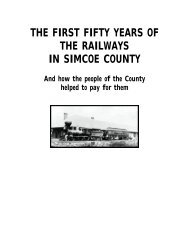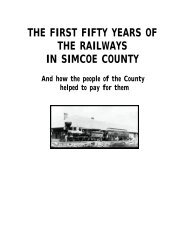xx Barrie's Sidewheeler
Create successful ePaper yourself
Turn your PDF publications into a flip-book with our unique Google optimized e-Paper software.
<strong>Barrie's</strong> <strong>Sidewheeler</strong><br />
Lake Simcoe and the first Steamship<br />
For the better part of the 19th century Lake Simcoe played a major role in<br />
the development of what became Central Ontario.<br />
In 1832, there was only a handful of settlers among the Indians of "The<br />
Narrows Village" at what became Orillia. With them were some<br />
enterprising half-pay British naval and military officers, who had settled<br />
along the shores of Lake Simcoe. They formed what today would be<br />
called a syndicate, to finance and build the first steamer on lakes not<br />
connected to rivers running to the ocean. They named their 90-foot ship<br />
"The Sir John Colborne" after the lieutenant-governor of the day. She was<br />
slow (just four miles per hour), built on a schooner hull; and was the<br />
ninth steamship built in Canada. The ship was built without the expertise<br />
of marine architects, and only 16 years after the first Canadian-built<br />
steamship, the SS Frontenac, slid into the Bay of Quinte waters off<br />
Kingston.<br />
These men may have settled far from the centres of commerce in Upper<br />
Canada, but they were very much in touch with spirit of the times.<br />
Although "The Sir John Colborne" was a commercial failure she was the<br />
forerunner of the steamships which were to ply Lake Simcoe. The era of<br />
the steamship on Lake Simcoe thus began.<br />
Before the coming of rail and road networks, water provided the quickest,<br />
most comfortable, and most efficient means of transportation in Upper<br />
Canada. Originally the boats plying the lake were canoes, bateaux (large,<br />
flat-bottomed row-boats measuring nearly 50 feet, in length), and sailing<br />
schooners.<br />
Rise of the Steamships<br />
Eventually steamships replaced these earlier modes of travel/ Many of<br />
them were handsome vessels that enjoyed long and successful careers.













